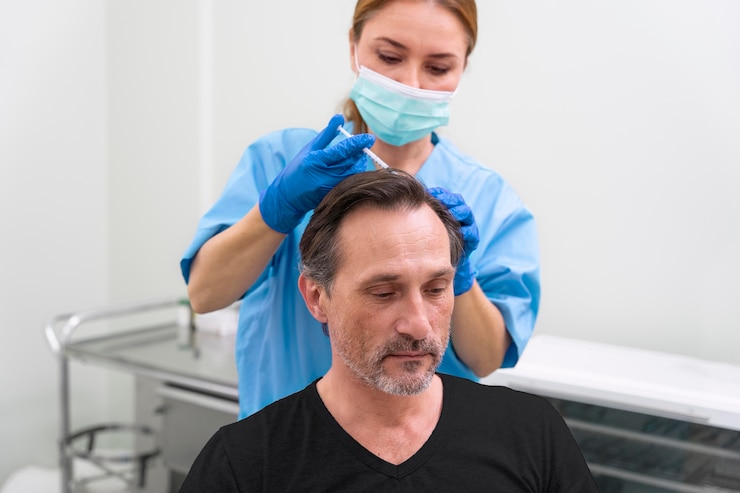Restore Your Hair's Glory with PRP Treatments

Hair loss can be a distressing experience, affecting not only your appearance but also your self-esteem. Fortunately, advancements in medical treatments offer promising solutions. One such innovative treatment gaining attention is Platelet-Rich Plasma (PRP) therapy. PRP treatments provide a natural approach to hair restoration, leveraging your body’s healing mechanisms to rejuvenate hair follicles and stimulate growth. This article explores how PRP In Dubai treatments work, their benefits, and what you can expect from this rejuvenating procedure.
What is PRP Therapy?
PRP therapy is a medical procedure that utilizes the body's platelets to promote healing and regeneration. Originally developed for orthopedic and sports medicine applications, PRP has gained popularity in dermatology and cosmetic treatments, particularly for hair restoration.
The procedure begins with a simple blood draw from the patient. The blood is then processed in a centrifuge, which separates it into its various components. The result is a concentrated solution of platelet-rich plasma rich in growth factors and proteins crucial for tissue repair and regeneration.
How PRP Works for Hair Restoration
The PRP solution, containing a high concentration of platelets, is injected into the scalp in areas affected by hair loss. The growth factors and proteins in PRP stimulate the hair follicles, promoting their regeneration and encouraging new hair growth.
Here’s how PRP therapy helps restore hair:
- Stimulates Hair Follicles: PRP injections rejuvenate dormant hair follicles, encouraging them to enter the active growth phase and produce new hair.
- Improves Hair Thickness: By nourishing the hair follicles, PRP therapy can increase the density and thickness of existing hair.
- Strengthens Hair: The growth factors in PRP help improve the overall health of the hair, making it less prone to damage and breakage.
- Enhances Blood Flow: PRP therapy increases blood flow to the scalp, delivering essential nutrients and oxygen to the hair follicles, which supports healthy hair growth.
Benefits of PRP Therapy
PRP therapy offers several benefits for individuals experiencing hair loss:
- Non-Surgical: Unlike hair transplant procedures, PRP is a non-invasive treatment that does not require surgery. This makes it a more accessible option for many individuals.
- Natural Approach: Since PRP therapy uses the patient's own blood, there is minimal risk of allergic reactions or adverse side effects.
- Minimal Downtime: The procedure involves only minor discomfort, and most patients can resume their normal activities shortly after treatment.
- Effective for Various Types of Hair Loss: PRP therapy can be effective for different types of hair loss, including androgenetic alopecia (pattern baldness), telogen effluvium (temporary hair shedding), and alopecia areata (patchy hair loss).
- Progressive Results: While results can vary, many patients notice improvements in hair density and thickness over time, with optimal results typically appearing after several sessions.
What to Expect During and After Treatment
Preparation: Before undergoing PRP therapy, a consultation with a healthcare provider is necessary to evaluate your suitability for the procedure and discuss your hair restoration goals.
Procedure: During the PRP treatment, a blood sample is taken and processed to extract the PRP solution. The PRP is then injected into the scalp using fine needles. The procedure generally takes about 30 to 60 minutes.
Post-Treatment Care: After the treatment, you might experience mild redness or swelling at the injection sites, which usually resolves within a few hours to days. It is important to follow your provider's aftercare instructions, which may include avoiding strenuous activities and direct sun exposure for a short period.
Follow-Up: PRP therapy typically involves multiple sessions to achieve the best results. Your healthcare provider will create a personalized treatment plan, which may include sessions every few weeks initially, followed by maintenance treatments at longer intervals.
Ideal Candidates for PRP Therapy
PRP therapy is suitable for individuals experiencing early to moderate hair loss who have healthy hair follicles and are looking for a non-surgical option. It is also a good choice for those who prefer a natural approach to hair restoration.
However, PRP may not be suitable for everyone. Individuals with certain medical conditions or unsuitable candidates for other hair loss treatments may need to explore alternative options. A thorough consultation with a healthcare provider can help determine if PRP therapy is the right choice for you.
Conclusion
PRP therapy represents a promising and innovative approach to hair restoration, harnessing the body’s natural healing capabilities to rejuvenate hair follicles and promote new growth. By stimulating dormant follicles and improving overall scalp health, PRP treatments offer a non-surgical, natural solution for those seeking to restore their hair’s glory. If you are considering PRP therapy, consult with a qualified healthcare provider to discuss your options and embark on your journey towards revitalized, healthier hair.